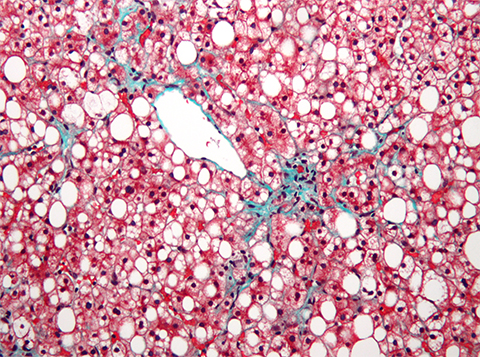From the journals: JLR
Leveraging TRIM38 in fatty liver disease progression and “no eating after bedtime.” Read about these papers recently published in the Journal of Lipid Research.
Leveraging TRIM38 in fatty liver disease progression
Non-alcoholic fatty liver disease, or NAFLD, affects more than a quarter of the world’s adult population. Patients with NAFLD can be asymptomatic or present with insulin resistance, fatigue and abdominal pain. NAFL, or simple steatosis, can evolve into nonalcoholic steatohepatitis, or NASH, cirrhosis, and, in some cases, liver cancer. Yet, no established pharmacological therapy exists for NASH.

In a recent study published in the Journal of Lipid Research, Xinxin Yao, Ruixiang Dong and colleagues from Taikang Medical School in Wuhan University and other research centers in China explored the potential of tripartite motif 38 protein, TRIM38, as a therapeutic approach to treat NAFLD and NASH.
TRIM38 is part of a superfamily of proteins with regulatory functions over the immune system and the inflammatory response. Specifically, TRIM38 prevents the activation of nuclear factor kappa-light-chain-enhancer of activated B cells, better known as NF-kB, a mediator of inflammation in mammalian tissues that can play a role in the pathogenesis of NAFLD.
The authors found that TRIM38 was downregulated in liver samples from human patients with NAFLD and that deleting TRIM38 in mice worsened high-fat diet–induced hepatic steatosis, inflammation and fibrosis. To confirm the role of TRIM38 in liver disease, the researchers overexpressed the protein in cultured hepatocytes and then exposed them to high concentrations of lipids in the culture media.
The study showed that TRIM38 suppresses expression of inflammation-related and lipid anabolism genes. These findings position TRIM38 as a promising therapeutic ally to help alleviate NAFLD and prevent progression towards NASH.
‘No eating after bedtime’
Do you enjoy late dinners and midnight snacks? You might want to reconsider. Studies have shown a positive correlation between night eating and obesity; that is, the later in the day you consume calories, the greater your chances of gaining weight.
Wenhao Ge, Qi Sun and colleagues at the Nanjing University of Science and Technology in China study the mechanism behind time-delayed eating patterns and body fat accumulation in mice. Their recent results were published in the Journal of Lipid Research.
The authors found that dietary oil is preferentially incorporated into triglycerides and accumulated in adipocytes, or fat cells, when consumed at night rather than during the day.
In mammals, biologically determined rhythms, also known as the circadian clock, control feeding behavior and feeding-related processes in organs and tissues. This study found that the circadian protein Period 1, or Per1, directly contributes to night eating–associated obesity by modulating the activity of two key enzymes responsible for hepatic bile acid production.
In the gut, bile acids are necessary for correct emulsification and absorption of fat. Accordingly, mice lacking Per1 could not absorb fat during night feeding and were thus resistant to high-fat diet–induced obesity. When the researchers treated mice lacking Per1 with cholic acid, one of the most abundant acids in bile, intestinal fat absorption and accumulation in the adipose tissue were partially restored.
This study suggests that Per1 could be a potential target in treating obesity.
Enjoy reading ASBMB Today?
Become a member to receive the print edition four times a year and the digital edition monthly.
Learn moreGet the latest from ASBMB Today
Enter your email address, and we’ll send you a weekly email with recent articles, interviews and more.
Latest in Science
Science highlights or most popular articles

Bacteriophage protein could make queso fresco safer
Researchers characterized the structure and function of PlyP100, a bacteriophage protein that shows promise as a food-safe antimicrobial for preventing Listeria monocytogenes growth in fresh cheeses.

Building the blueprint to block HIV
Wesley Sundquist will present his work on the HIV capsid and revolutionary drug, Lenacapavir, at the ASBMB Annual Meeting, March 7–10, in Maryland.

Gut microbes hijack cancer pathway in high-fat diets
Researchers at the Feinstein Institutes for Medical Research found that a high-fat diet increases ammonia-producing bacteria in the gut microbiome of mice, which in turn disrupts TGF-β signaling and promotes colorectal cancer.

Mapping fentanyl’s cellular footprint
Using a new imaging method, researchers at State University of New York at Buffalo traced fentanyl’s effects inside brain immune cells, revealing how the drug alters lipid droplets, pointing to new paths for addiction diagnostics.

Designing life’s building blocks with AI
Tanja Kortemme, a professor at the University of California, San Francisco, will discuss her research using computational biology to engineer proteins at the 2026 ASBMB Annual Meeting.

Cholesterol as a novel biomarker for Fragile X syndrome
Researchers in Quebec identified lower levels of a brain cholesterol metabolite, 24-hydroxycholesterol, in patients with fragile X syndrome, a finding that could provide a simple blood-based biomarker for understanding and managing the condition.

